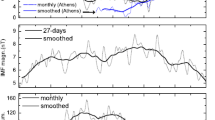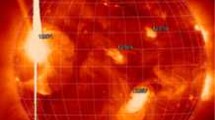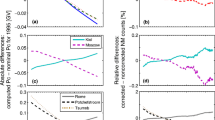Abstract
Hourly cosmic-ray intensities, recorded by 15 neutron monitor detectors in both Earth hemispheres, have been analyzed according to the interplanetary magnetic field (IMF) polarity sense (Toward (T) or Away (A)) to examine the asymmetry of solar diurnal variations (amplitudes and phases) during the time interval from 1975 to 2013. The vertical geomagnetic cut-off rigidity of these detectors is \(R_{\mathrm{o}} \leq 13~\mbox{GV}\). Previously, the north–south asymmetries of cosmic-ray intensity, between the northern and southern sectors with respect to the neutral sheet, have been studied for different periods to give an explanation as regards the cosmic ray flow in the direction parallel to the rotation axis of the Earth. The observed cosmic ray asymmetries between the two sectors were related to a corresponding N–S asymmetry of solar activity. Our results showed that during the years of minima and maxima solar activity cycles, asymmetric of latitudinal southward or northward gradients have been observed at both hemispheres. In addition, the southward and northward cosmic ray latitudinal gradients were frequently observed at stations on both hemispheres during the active period of the northern and/or southern hemispheres of the Sun. On the other hand, the differences in the solar diurnal (T–A) vectors show that the time of maximum depends on latitude at the point of observation. In addition, when the interplanetary magnetic field IMF was directed away from the Sun north of the current sheet, the northern solar diurnal vectors (T–A) shifted to later hours. Moreover, when the solar magnetic field is reversed, the phase of solar diurnal (T–A) vectors changed from 1 to 11 h, and from 3 to 9 h for northern and southern observations, respectively.




Similar content being viewed by others
References
Badruddin, O.P.M.: 2012, Solar Phys. 279, 269.
Ballester, J.L., Oliver, R., Carbonell, M.: 2005, Astron. Astrophys. 431, L5.
Bendat, J.S., Piersol, A.G.: 2000, Random Data Analysis and Measurements, 3rd edn. Wiley, New York.
Carbonell, M., Oliver, R., Ballester, J.L.: 1993, Astron. Astrophys. 274, 497.
Dorman, L.I.: 1957, Cosmic Rays Variations, State Pub. House, for Technical and Theoretical Literature, Moscow.
Dorman, L.I.: 2004, Cosmic Rays in the Earth’s Atmosphere and Underground 303, Kluwer Academic, Dordrecht, 3.
Duchlev, P.: 2001, Solar Phys. 199, 211.
El-Borie, M.A.: 1999, Astropart. Phys. 10, 165.
El-Borie, M.A.: 2001a, Astropart. Phys. 16, 169.
El-Borie, M.A.: 2001b, J. Phys. G, Nucl. Part. Phys. 27, 773.
El-Borie, M.A., Al-Thoyaib, S.S.: 2002, Nuovo Cimento C 25C, 353.
El-Borie, M.A., Darwish, A.A., Bishara, A.A.: 1995, Cosmic ray solar diurnal variations gradients and the interplanetary magnetic field. In: Proc. 24th Inter. Cosmic Ray Conf., Rome 4, 599.
El-Borie, M.A., Darwish, A.A., Bishara, A.A.: 1996, Solar Phys. 167, 395.
El-Borie, M.A., Duldig, M.L., Humble, J.E.: 1998, Planet. Space Sci. 46, 439.
EL-Borie, M.A., Sabbah, I.S., Bishara, A.A.: 1996, Astron. Nachr. 317, 267.
Hathaway, D.H.: 2015, Living Rev. Solar Phys. 12, 4. DOI .
Hall, D.L., Duldig, M.L., Humble, J.E.: 1996, Space Sci. Rev. 78, 401.
Joshi, B., Joshi, A.: 2004, Solar Phys. 219, 343.
Kane, R.P.: 2003, J. Geophys. Res. 108, 1379.
Knaack, R., Stenflo, J.O., Berdyugina, S.V.: 2004, Astron. Astrophys. 418, L17.
Kudela, K., Sabbah, I.: 2016, Sci. China, Technol. Sci. 59, 547.
Kumar, S., Agarwal, S.R., Mishra, R., Dubey, S.K.: 2002, Int. J. Mod. Phys. D 11, 1243.
Li, K., Schmieder, J., Li, B., Sh, Q.: 1998, Astron. Astrophys. 131, 99.
Li, K.J., Wang, J.X., Zhan, L.S., Yun, H.S., Liang, H.F., Zhao, H.J., Gu, X.M.: 2003, Solar Phys. 215, 99.
Mavromichalaki, H., Papageorgiou, Ch., Gerontidou, M.: 2016, Astrophys. Space Sci. 361, 69.
McCracken, K.G., Ness, N.F.: 1966, J. Geophys. Res. 71, 3315.
Mishra, R.M., Agarwal, R.: 2008, J. Phys. Stud. 2, 76.
Ngobeni, M.D., Potgieter, M.S.: 2011, Adv. Space Res. 48, 300.
Okazaki, Y., Fushishita, A., Narumi, T., Kato, C., Yasue, S., Kuwabara, T., Bieber, J.W., Evenson, P., Silva, M.R.D., Lago, A.D., Schuch, N.J., Fujii, Z., Duldig, M.L., Humble, J.E., Sabbah, I., Kóta, J., Munakata, K.: 2008, Astrophysics 681, 693.
Rao, U.R., McCracken, K.G., Allum, F.R., Ralmeria, R.A., Palmer, I.: 1971, Solar Phys. 19, 209.
Roy, J.R.: 1977, Solar Phys. 52, 53.
Sabbah, I.: 2013, J. Geophys. Res. 118, 4739.
Sabbah, I., Rybansky, M.: 2006, J. Geophys. Res. 111, A01105.
Shrivastava, K., Pankaj, K.: 2010, Indian J. Radio Space Phys. 39, 341.
Simpson, J.A., Zhang, M., Bame, S.: 1996, Astrophys. J. 465, L69.
Singh, M., Badruddin: 2006, Solar Phys. 233, 291.
Singh, M., Singh, Y.P., Badruddin: 2008, J. Atmos. Solar-Terr. Phys. 70, 169.
Singh, A., Dubey, D., Singh, R.P., Tiwari, A.K.: 2013, Int. J. Innov. Res. 2, 9.
Storini, M., Borello-Filisetti, D., Mussinov, V., Parisi, M., Sykora, J.: 1995, Solar Phys. 157, 375.
Stozhkov, Yu.I., Bazilevskaya, G.A., Pokrevskij, P.E., Svirzhevskij, N.S.: 1996 Doklady Akademii Nauk 28, Rossijskaya Akademiya Nauk, Moscow, 395.
Svirzhevskaya, A.K., Svirzhevsky, N.S.: 2003, Int. J. Geomagn. Aeron. 4, 111.
Svirzhevskaya, A.K., Bazilevskaya, G.A., Svirzhevsky, N.S., Krainev, M.B.: 1997, Adv. Space Res. 19, 929.
Svirzhevsky, N.S., Svirzhevskaya, A.K., Bazilevskaya, G.A., Stozhkov, Yu.I.: 2005, Adv. Space Res. 35, 671.
Swinson, D.B., Koyama, H., Saito, T.: 1986, Solar Phys. 106, 35.
Swinson, D.B., Shea, M.A., Smart, D.F., Humble, J.E.: 1990, Proc. 21st Inter. Cosmic Ray Conf. 6, 75.
Swinson, D.B., Humble, J.E., Shea, M.A., Smart, D.F.: 1991, J. Geophys. Res. 96, 1757.
Temmer, M., Veronig, A., Hanslmeier, A., Otruba, W., Meserotti, M.: 2001, Astron. Astrophys. 375, 1049.
Acknowledgements
Data for all cosmic ray stations were collected via the WDC & IZMIRAN data center, Russia. We are very grateful to the National Space Science Data Center (NASA) for the hourly IMF data and for making the interplanetary data available online. We are very thankful to the referees for their valuable comments and suggestions.
Author information
Authors and Affiliations
Corresponding author
Ethics declarations
Disclosure of Potential Conflicts of Interest
The authors declare that they have no conflicts of interest.
Rights and permissions
About this article
Cite this article
El-Borie, M.A., Abdel-halim, A.A., El-Monier, S.Y. et al. North–South Asymmetry of Solar Diurnal Variations of Cosmic-Ray Intensity Throughout the Period 1975 – 2013. Sol Phys 291, 3817–3830 (2016). https://doi.org/10.1007/s11207-016-0990-2
Received:
Accepted:
Published:
Issue Date:
DOI: https://doi.org/10.1007/s11207-016-0990-2




